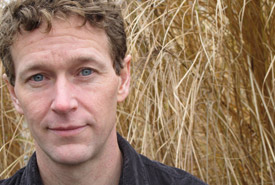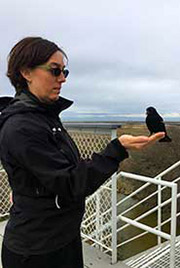Rewilding Canada: An interview with J.B. MacKinnon

JB MacKinnon
In 2005, JB MacKinnon and his partner Alisa Smith embarked on a year long journey to feed themselves exclusively from locally-sourced foods. Their experiment gave birth to the 100 Mile Diet concept, which was popularized in their book that chronicled the trials and tribulations of surviving on foods produced within, you guessed it, 100 miles of their hometown of Vancouver. At the centre of their book is the question of how we can live sustainably on the small corner of the world in which we actually live.
MacKinnon’s newest book tackles our relationship with the natural world from another angle. The Once and Future World: Nature As It Was, As It Is, As It Could Be re-imagines nature and shows that in restoring the living world, we are also restoring ourselves.
MacKinnon proposes the idea of rewilding — to bring wildness back into all spaces of the planet in whatever ways that we can. Rewilding, MacKinnon suggests, means to support nature’s potential — its capacity to sustain an abundance and variety of life.
To further explore the ideas in his book, MacKinnon partnered with the Museum of Vancouver to guest-curate an exhibition called Rewilding Vancouver. The exhibition uses taxidermy specimens, 3D models, soundscapes, videos and photo interventions to challenge viewers’ assumptions about what is natural to Vancouver. (The exhibition runs until September 1, 2014 and is presented by the Pacific Salmon Foundation.)
The Nature Conservancy of Canada (NCC) is excited to co-present a Conservation Speakers Series talk by JB MacKinnon at the Museum of Vancouver on Friday, April 11. Find out more about this event >
Recently, Lesley Marian Neilson, NCC’s communications manager in BC, spoke with MacKinnon about some of the ideas that he raises in The Once and Future World. What follows is part one of a two-part interview (read part two here).
LMN: How did you come to write this book? Where did it come from?
JM: It came from two things. One was the experience of doing the 100 mile diet, because Alisa and I were finding it difficult to find enough food for two people to live off of in Vancouver. I kept thinking of the fact that thousands of thousands of First Nations people had lived here in the past, and it mystified me how they could have fed themselves, until I went back and read descriptions of the natural world at that time and realized that the natural world had been quite a different place. It had a great deal more ecological wealth for people to draw on.
The other motivator for this book was the scene I describe at the beginning when I went home to the grasslands I grew up in and found that the places I knew and loved best were being built over by urban sprawl. It twigged in me the desire to really dig into the depth of those transformations. So I disappeared into the archives in Kamloops, and what I found there just staggered me. Not only had things changed on the landscape, but that those transformations didn’t seem to be part of the shared community memory.
Between those two things I started to wonder to what extend that depth of human transformation of the landscape extended over the globe.
LMN: This is what you refer as the shifting baseline, where each generation forgets the abundance of the past and instead sees the current state of nature as how things have always been. What role does the shifting baseline play in our impact on the natural world?
JM: I see this memory loss in both pessimistic and optimistic light. On the one hand, it is frightening how easily and quickly we can lose sight of what a natural condition was in the past. On the other hand it’s a little bit forgiving of how what we tend to think drives the transformation of nature by human action. Most of us think the main driver of degradation of the landscape is greed — human rapaciousness — but the memory loss adds complexity to that. It suggests we’re not always wanting to take more, but that we’re only taking a little piece without realizing how much we have already taken.
LMN: This book paints a really compelling picture of what the natural world would have looked like hundreds, and in some cases thousands, of years ago. It really shows how much we have lost.
JM: I really tried to give some people a sense of the abundance of the past. But what’s really interesting is that you can go back to the 1800s and find people expressing the same feelings of lost abundance that we have today.
I found a quote by Thoreau that says, “When I consider that the nobler animals have been exterminated here — the cougar, the panther, lynx, wolverine, bear, deer, the beaver, the turkey, and so forth, I cannot but feel I live in a tamed and therefore emasculated country.”
That’s Thoreau writing in the 1800s.
He goes on to say, “I take infinite pains to know all the phenomena of the spring, for instance, thinking that I have here the entire poem, and then, to my chagrin, I hear that it is but an imperfect copy that I possess and have read, that my ancestors have torn out many of the first leaves and grandest passages, and mutilated it in many places.”
We’re looking at the world today, wondering what the world would have looked like 150 years ago, and here’s Thoreau having the same thoughts about a place we would consider quite a wild country.
LMN: One of the biggest threats to our native landscapes is the introduction and encroachment of invasive alien species. Considering that the natural world is always transforming and changing over time, should we reconsider our approach to managing invasive species? Should some be accepted as new novel ecosystems?
JM: Sure. One thing I realized is that we’re surrounded by introduced species all the time and in ways we don’t anticipate. Much if not most of North America had no earthworms prior to European contact, which illustrates that sometimes these introduced species are present all around us in ways that make it hard for us to notice that they’re having a negative impact and also in ways that are absolutely hopeless to try to unwind. There’s simply no way we’re going to get rid of North America’s earthworms!
LMN: And as gardeners we celebrate them!
JM: Exactly. And yet they do actually have negative impacts in some places. Earthworms have transformed and simplified the forest floor in the eastern half of North America, and there is some indication that they are starting to move into the forests of BC. No one really knows what the consequences of this will be, and it’s quiet hopeless to try to put the horse back in the barn.
Unfortunately, the more you learn about this stuff the more it complexifies rather than simplifies. I don’t think there is any single approach that we can take to things like invasive species except by careful case by case analysis. There are good reasons to try to limit or eliminate those invasive species that cause the greatest degree of ecological harm and where it seems possible to limit or eliminate them. We should also pay a great deal more attention at the broadest level to scale back the rate of introduction of new species into our landscapes. Today the human driven introduction of species to new landscapes far outpaces the natural introduction of new species.
We are already living with a lot of introduced species and novel ecosystems now, and we certainly will be in the future.
Come back on April 9, 2014 for part two of this interview.


